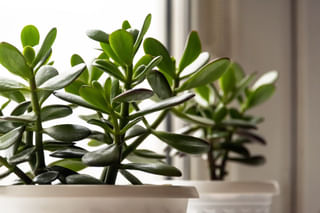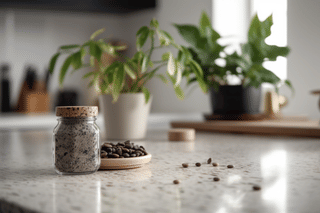Which houseplants like coffee grounds?
Discover the benefits of using coffee grounds for your indoor plants. Learn which plants thrive with a boost of nitrogen and how to safely incorporate coffee into your plant care routine. Understand how to best use coffee grounds as fertilizer during the growing season.
If you're a coffee drinker and a plant enthusiast, you're in for a treat! Instead of throwing away your coffee grounds, did you know they could use them for your houseplants?
Many houseplants thrive with the use of coffee grounds for a few reasons. They're rich in nitrogen, a nutrient that helps your plant grow, and they also improve the soil.
However, not all plants like your old coffee grounds, so let's dive into which houseplants can turn your coffee waste into new growth.
Are you ready to give your plants a boost? Let's get started!
Why do coffee grounds help houseplants?
Do you know why coffee grounds help your plants to grow? No? Let's look at a few different ways!
Firstly, coffee grounds are a great source of organic material. They help improve the soil structure, which is good for root development. Their coarse texture also helps to aerate the soil, improving its drainage and preventing waterlogging, a common issue that can lead to root rot.
Secondly, coffee grounds are a natural fertilizer. They are rich in nitrogen, which your plant needs to grow. Nitrogen promotes the production of chlorophyll, a pigment that aids in the process of photosynthesis, which is how plants convert light energy into food.
Coffee grounds also contain other essential nutrients like potassium, which aids in the synthesis of plant proteins, and magnesium, which plays a role in photosynthesis and the creation of DNA.
What type of plants benefit from coffee grounds?
There are a few different types of plants that can benefit from some coffee grounds now and then. The plants that benefit most from used coffee grounds are plants that like acidic soil, moisture-loving plants, and plants that do well with a nitrogen boost from time to time.
If you've got moisture-loving plants, used coffee grounds are a good addition to mix in with the soil, as coffee grounds hold onto moisture, while also improving the drainage of the growing medium. This helps to prevent waterlogging of the soil.
Plants, like a Sansevieria, that grow well with the nitrogen boost, but don't like moist soil, can still benefit from coffee grounds. There are different ways to use coffee grounds with houseplants, so even drought-loving houseplants can benefit from coffee grounds without becoming overwatered.
I'll mention the following now and I'll repeat it again when explaining how you can use coffee grounds with your houseplants: while coffee grounds can be beneficial, it's essential to use them in moderation. Applying them too often can make the soil too acidic, which could harm your plants rather than help them.
Which plants like coffee grounds?
We've already seen some of the plants that can benefit from used coffee grounds now and then, but I'm sure you're looking for a list of specific houseplants to use your coffee grounds with. While the list below is not complete, it gives you an idea of the plants that like coffee grounds:
- Christmas Cactus (Schlumbergera truncata)
- Pothos (Epipremnum aureum)
- Philodendron
- African Violet
- Cyclamen
- Azaleas
- Hydrangeas
- Ferns
- Peace Lily (Spathiphyllum)
- Jade Plant (Crassula Ovata)
- Alocasia Zebrina
- Alocasia Amazonica
- Forget-Me-Not
- Hibiscus
- Snake plant (Sansevieria Trifasciata)
Now that we've explored the benefits of coffee grounds and which houseplants can benefit from them, let's find out how to use coffee grounds effectively. We'll cover the best ways to incorporate this natural fertilizer into your plant care routine and discuss some common mistakes to avoid, ensuring your houseplants not only survive but thrive!
What type of coffee grounds should I use for houseplants?
It turns out that the best coffee grounds to use for your indoor plants are regular coffee without added flavors. You can use either regular or decaf coffee grounds for your indoor houseplants and when prepared correctly, both will provide sufficient nutrients for your plants. The key here is to allow the coffee grounds to dry out properly before using them in your plant care routine.
By letting it dry out, it's easier to incorporate into the soil and less messy to handle in general.
Can I use fresh coffee grounds for houseplants?
The short answer is: No. Before using coffee grounds, make sure that they are used coffee grounds and not fresh ones. Fresh coffee grounds are acidic, which can be harmful to your plants. Used coffee grounds are neutral or slightly acidic, making them safe for use in your plant care routine.
How can coffee grounds be used on houseplants?
When it comes to using coffee grounds for your plants, it's important to start with what you shouldn't do. Never pour hot or cold coffee directly onto your plants. Coffee can retain moisture, and excessive amounts can lead to root damage due to oversaturation.
Too much caffeine can stop plant growth and increase the risk of fungal diseases. The key is moderation and proper processing because less is more. Here are four ways to safely introduce coffee to your plants.
1. Compost with coffee grounds
By incorporating coffee grounds into your compost, you're adding organic matter that helps make the soil more biologically active. Mix coffee grounds (green compost matter) with brown compost materials like leaves or shredded paper.
For a good mixture, use 2 parts of brown compost matter to 1 part of green compost matter. The resulting balanced compost can be mixed into or placed on top of the potting soil for your indoor plants. This provides your plants with lots of nutrients they can use to grow.
2. Mix coffee grounds into the potting mix
When repotting a plant, consider mixing in a small amount of used coffee grounds. Coffee grounds stimulate the growth of microorganisms that use nitrogen to grow and reproduce. A ratio of one part used coffee grounds to three parts potting mix is a good mix.
3. Create "coffee ground tea" as a fertilizer
Used coffee grounds can be brewed into a liquid fertilizer, often called "coffee ground tea". Combine used coffee grounds with water at a ratio of two cups of coffee to five gallons of water. Let the mixture sit for three days, and stir occasionally.
After this period, strain the mixture using a fine mesh strainer to remove the coffee grounds. This leaves a nutrient-rich liquid behind that you can add to your watering can and help to feed your plant while watering it.
4. Use coffee grounds as mulch
Coffee grounds can also be used as mulch. Some gardeners claim that mixing coffee grounds with mulch can prevent pests, as coffee is toxic to these pests.
One good use of mulching or "top-dressing" your soil with used coffee grounds is you spread the nitrogen in the coffee throughout the soil when watering your plant, but it doesn't make the soil retain more water. This is perfect for plants like the Sansevieria and the Christmas Cactus.
Keep seasonal changes in mind
Keep in mind seasonal changes when using coffee grounds, much like you would with traditional fertilizer. The best time to use coffee grounds as fertilizer is during the growing seasons of spring and summer. You should use it during the winter when your plants are dormant and not really growing.
Conclusion
Using coffee grounds for your houseplants is an eco-friendly and cost-effective way to fertilize your plants, repel pests, and improve soil structure. However, remember always to use coffee grounds in moderation and research your plant's specific needs before adding them to the soil. With proper use, coffee grounds can be a valuable addition to your plant care routine.
Thank you for reading this post! I hope it helps you to keep your plants healthy and beautiful! If you're looking for more guides on specific plants, you can always request a plant guide to get a guide for the plant you have trouble with.
Test your plant care knowledge
Quiz completed!
Want to learn more? Sign up for my newsletter to receive free tips in your inbox!
Sign up now!
















